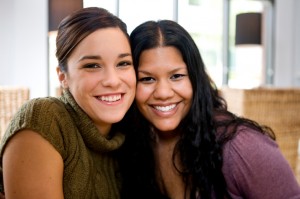 Urinary urgency is the sudden, overwhelming feeling of the need to urinate. Urinary urgency can disrupt sleep, work, sexual activity, relationships and social interaction. Women who frequently experience urinary urgency usually knows where the nearest bathroom is located (toilet mapping). When the urge strikes they rush to the bathroom and the uncomfortable urge sensation is relieved. If they fail to get there in time, an accidental loss of urine may occur and is referred to urinary urge incontinence. The loss of urine can vary between a few drops to a large amount. Urgency and urge incontinence are often associated with the need to urinate more frequently (frequency of more than eight times per 24 hours), and the need to get up at night to urinate (nocturia). Women who regularly experience urinary urgency and frequency (with or without nocturia or incontinence) have a condition called urinary urgency syndrome (also called overactive bladder or OAB). Their daily lives are influenced, and frequently controlled, by their bladders. These symptoms can lead women to change behaviors and adopt preventive coping mechanisms, such as limit daily travel, quit exercising and dancing, reducing fluids, avoiding sexual intimacy, and wearing pads or adult diapers.
Urinary urgency is the sudden, overwhelming feeling of the need to urinate. Urinary urgency can disrupt sleep, work, sexual activity, relationships and social interaction. Women who frequently experience urinary urgency usually knows where the nearest bathroom is located (toilet mapping). When the urge strikes they rush to the bathroom and the uncomfortable urge sensation is relieved. If they fail to get there in time, an accidental loss of urine may occur and is referred to urinary urge incontinence. The loss of urine can vary between a few drops to a large amount. Urgency and urge incontinence are often associated with the need to urinate more frequently (frequency of more than eight times per 24 hours), and the need to get up at night to urinate (nocturia). Women who regularly experience urinary urgency and frequency (with or without nocturia or incontinence) have a condition called urinary urgency syndrome (also called overactive bladder or OAB). Their daily lives are influenced, and frequently controlled, by their bladders. These symptoms can lead women to change behaviors and adopt preventive coping mechanisms, such as limit daily travel, quit exercising and dancing, reducing fluids, avoiding sexual intimacy, and wearing pads or adult diapers.
Urinary urgency can be caused by two general categories of disorders: Physical and Habitual
Physical Causes of Urinary Urgency
1. Infection in the bladder or urethra
2. Polyps or tumors in the bladder or urethra
3. Caffeine, citrus juices and alcohol
4. Diabetes Mellitus
5. Interstitial cystitis
6. Neurologic disorders (multiple sclerosis, Parkinson’s disease, spinal cord trauma)
Physical causes can usually be diagnosed with office testing called urodynamics. Actual bladder contractions (called motor urgency or detrusor instability) are usually due to a specific physical disorder. Treatment is directed at both the cause and symptoms.
Habitual
The normal bladder will hold at least 15 oz. (450 cc) of urine. When your bladder is “full”, you feel the urge to urinate. However, you should normally be able to suppress that urge, until it is convenient to go to the bathroom. The brain initiates the process of urinating after you are sitting on the toilet by sending nerve impulses to the urethra to relax and to the bladder to contract. When the pressure within the bladder exceeds the pressure in the urethra, urine flows (hopefully into the toilet).
If the bladder contracts abnormally (bladder instability), a sudden increase in pressure within the bladder signals the brain to start the voiding reflex. A sense of urinary urgency may occur and if the pressure in the bladder exceeds that in the urethra, loss of urine will occur. When there is no physical cause of urgency (habit), there usually is no increase in bladder pressure. However, the brain can learn to associate specific actions, places or times with the feeling of the need to urinate. However, it is usually not associated with a bladder contraction or with a full bladder.
Most commonly, urinary urgency or overactive bladder develops gradually over time. It is frequently associated with stress urinary incontinence (loss of urine associated with sudden increases in abdominal pressure, such as coughing, sneezing, laughing, running, etc.). Patients may learn that voiding more frequently may decrease the amount or urine loss with stress incontinence episodes. Often the sudden onset of urinary urgency can be associated with a specific activity; i.e., driving into your driveway at home, inserting your house key into the door lock, putting your hands under running water, or even seeing a bathroom. In most cases, the bladder function is normal and the brain is sending false messages (sensory urgency).
Completing a Urinary Incontinence Questionnaire and a 24-hour Voiding Diary, a pelvic floor physical examination and simple office bladder testing (Urodynamics) can usually establish a definite diagnosis. Correction of habitual urinary urgency involves a bladder-retraining program. Surgery is rarely indicated.
Treatment of Habitual Urinary Urgency and Incontinence:
The goal of a bladder-retraining program is to regain control and not be a victim of your bladder. This will always include the first two listed below.
1. Awareness and Refocusing:
Bladder retraining begins with understanding the mechanism of urinating (discussed above) and reconditioning the urgency reflex. Postponing the act of urinating without leaking any urine can be achieved with changing your focus whenever the urge to urinate strikes. Consider taking the following steps:
(a) When the urge strikes, stay still and do 3-4 ‘Slow Twitch’ Kegel pelvic contractions AND
(b) Visualize walking slowly to the bathroom to perform any task other than
(c) Then, act out your visualization sitting on the toilet (i.e. adjusting the towels, sorting the medicine cabinet, etc.)
(d) After you have completed your task, proceed to use the toilet. thinking of the act of urinating.
Simply put: this mental refocusing along with the pelvic contractions will delay your brain from sending impulses to your bladder and urethra until you are actually ready to urinate.
2. Pelvic Floor (Kegel) Exercises – this program of strengthening your pelvic floor muscles should be a part of your normal urinating routine and is performed every time you finish urinating Refer to article entitled ‘Kegel Exercises – How to Strengthen Your Pelvic Muscle’.
When these two steps are not as successful as you wish, then the following programs may bring success.
1. Medications – various drugs that relax your bladder may be used to relieve the sense of urgency. These can cause a sense of dryness in your mouth. If this side effect occurs, suck on hard candy rather than drink excessive fluids. Common medications include Detrol LA 4 mg., Ditropan 5, 10, 15 mg, Vesicare 5, 10 mg,
2. Time Voiding Program – this is a program in which you will be urinating at fixed time intervals and doing your best to suppress the urge to urinate until the next scheduled time.
3. Pelvic Floor Electrical Stimulation – this is a device, which is inserted into the vagina and painlessly causes your pelvic floor muscles to contract. This program is used only after the other programs have been tried and your urinary urgency symptoms persist.
4. Biofeedback – a program designed to help you suppress the urge and postpone urinating.
Contact Dr. Gordon Gunn today at (714) 912-2211 to schedule an appointment.
Dr. Gordon Gunn also proudly serves Buena Park, La Mirada, Yorba Linda, Diamond Bar, Walnut, and surrounding areas.
 Having an overactive bladder can be distressing. It can ruin daily plans and interrupt sleep. Not sure if you have an overactive bladder? Below are some symptoms that can help you determine if you have an overactive bladder:
Having an overactive bladder can be distressing. It can ruin daily plans and interrupt sleep. Not sure if you have an overactive bladder? Below are some symptoms that can help you determine if you have an overactive bladder:






